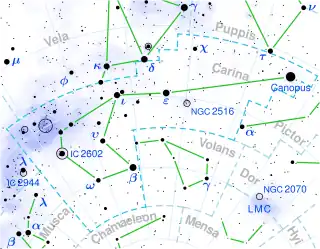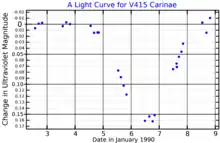 | |
| Observation data Epoch J2000.0 Equinox J2000.0 (ICRS) | |
|---|---|
| Constellation | Carina |
| Right ascension | 06h 49m 51.31414s[1] |
| Declination | −53° 37′ 20.8182″[1] |
| Apparent magnitude (V) | +4.40[2] ([3]) |
| Characteristics | |
| Spectral type | G6II + A1V[4] |
| U−B color index | +0.61[2] |
| B−V color index | +0.92[2] |
| R−I color index | +0.45[2] |
| Variable type | EA[3] |
| Astrometry | |
| Radial velocity (Rv) | 26.0 ± 0.9[5] km/s |
| Proper motion (μ) | RA: −1.99[1] mas/yr Dec.: 17.58[1] mas/yr |
| Parallax (π) | 5.99 ± 0.18 mas[1] |
| Distance | 182[4] pc |
| Absolute magnitude (MV) | –1.58[6] |
| Orbit[7] | |
| Period (P) | 195.245 days |
| Eccentricity (e) | 0.00585 |
| Inclination (i) | 82.7° |
| Semi-amplitude (K1) (primary) | 24.2535 km/s |
| Semi-amplitude (K2) (secondary) | 38.6[4] km/s |
| Details[4] | |
| A | |
| Mass | 3.14 M☉ |
| Radius | 31.3 R☉ |
| Luminosity | 537 L☉ |
| Surface gravity (log g) | 1.94 cgs |
| Temperature | 4,981 K |
| B | |
| Mass | 1.98 M☉ |
| Radius | 1.9 R☉ |
| Luminosity | 25 L☉ |
| Surface gravity (log g) | 4,18 cgs |
| Temperature | 9,388 K |
| Metallicity | −0.04 |
| Other designations | |
| Database references | |
| SIMBAD | data |
HR 2554, also known as V415 Carinae and A Carinae, is an eclipsing spectroscopic binary of the Algol type in the constellation of Carina whose apparent visual magnitude varies by 0.06 magnitude and is approximately 4.39 at maximum brightness. Its primary is a G-type bright giant star and its secondary is an A-type main-sequence star. It is approximately 553 light-years from Earth.
HR 2554 A
The primary component, HR 2554 A, is a yellow G-type bright giant with a mean apparent magnitude of +4.4.
HR 2554 B
The secondary component, HR 2554 B, is a white A-type main-sequence dwarf, about three magnitudes fainter than the primary.
HR 2554 binary system

HR 2554 has two components in orbit around each other, making it a binary star. The semi-major axis of the secondary's orbit is 2.17 arcseconds. The two components regularly eclipse each other, making A Carinae a variable star. Its brightness varies by 0.06 magnitude with a period equal to its orbital period of 195 days.[3]
References
- 1 2 3 4 5 Van Leeuwen, F. (2007). "Validation of the new Hipparcos reduction". Astronomy and Astrophysics. 474 (2): 653–664. arXiv:0708.1752. Bibcode:2007A&A...474..653V. doi:10.1051/0004-6361:20078357. S2CID 18759600.
- 1 2 3 4 HR 2554, database entry, The Bright Star Catalogue, 5th Revised Ed. (Preliminary Version), D. Hoffleit and W. H. Warren, Jr., CDS ID V/50. Accessed on line August 23, 2008.
- 1 2 3 Samus, N. N.; Durlevich, O. V.; et al. (2009). "VizieR Online Data Catalog: General Catalogue of Variable Stars (Samus+ 2007-2013)". VizieR On-line Data Catalog: B/GCVS. Originally Published in: 2009yCat....102025S. 1. Bibcode:2009yCat....102025S.
- 1 2 3 4 Brown, Alexander; Bennett, Philip D.; Baade, Robert; Kirsch, Thomas; Reimers, Dieter; Hatzes, Artie P.; Kürster, Martin (2001). "Ultraviolet Eclipse Observations and Fundamental Parameters of the Binary HR 2554 (G6 II+A1 V)". The Astronomical Journal. 122 (1): 392–401. Bibcode:2001AJ....122..392B. doi:10.1086/321125.
- ↑ Wilson, Ralph Elmer (1953). "General catalogue of stellar radial velocities". Washington. Bibcode:1953GCRV..C......0W.
- ↑ Ammler-von Eiff, Matthias; Reiners, Ansgar (June 2012), "New measurements of rotation and differential rotation in A-F stars: are there two populations of differentially rotating stars?", Astronomy & Astrophysics, 542: A116, arXiv:1204.2459, Bibcode:2012A&A...542A.116A, doi:10.1051/0004-6361/201118724, S2CID 53666672.
- ↑ Komonjinda, Siramas; Hearnshaw, John B.; Ramm, David J. (2011). "Orbital solutions for six spectroscopic binaries with circular or nearly circular orbits". Monthly Notices of the Royal Astronomical Society. 410 (3): 1761. Bibcode:2011MNRAS.410.1761K. doi:10.1111/j.1365-2966.2010.17558.x.
- ↑ Schröder, K. P.; Hünsch, M. (April 1992). "Optical spectra of ζ Aurigae systems. IV. The January 1990 eclipse of HR 2554 : detection of chromospheric absorption and extended plasma at ≈ 105 K". Astronomy & Astrophysics. 257: 219–227. Bibcode:1992A&A...257..219S. Retrieved 22 November 2021.